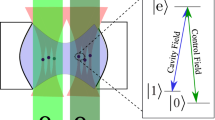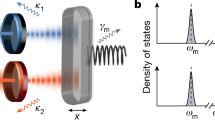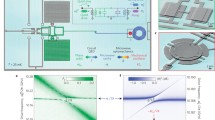Abstract
A novel method for controlling and manipulating quantum states of both matter and field has been developed. The approach has been applied to govern the population in rotational levels of weakly aligned molecules. This technique entails the use of an adiabatically varying electric field to interact with dipole molecules. The interaction of weakly aligned molecules with a microwave field within a high finesse cavity indicates the feasibility of achieving population inversion, rendering them well suited for maser operation even at room temperature. In addition to this, the research has shown that the absorption of molecules can be controlled too making it exceptionally well suited for gas sensing with high sensitivity and selectivity. These sensors hold promise across diverse domains, including technology, the sciences, environmental monitoring, biology, and medicine. Furthermore, the technique has the potential for employing control techniques to vacuum fields that holds promise for the generation of strongly correlated, entangled photons. This development could have far-reaching implications in quantum technology, and various applications in quantum information science and beyond.







Similar content being viewed by others
Data availability
No data are associated with this manuscript.
References
J.P. Gordon, H.J. Zeiger, C.H. Townes, The maser-new type of microwave amplifier, frequency standard, and spectrometer. Phys. Rev. 99(4), 1264 (1955). https://doi.org/10.1103/PhysRev.99.1264
M. Bertolotti, The History of the Laser (CRC Press, NewYork, 2004)
M. Oxborrow, J. Breeze, N. Alford, Room-temperature solid-state maser. Nature 488, 353–356 (2012). https://doi.org/10.1038/nature11339
J.D. Breeze, E. Salvadori, J. Sathian, N. McN, C.W.M. Alford, Kay., Continuous-wave room-temperature diamond maser. Nature 555(7697), 493 (2018). https://doi.org/10.1038/nature25970
M. Lemeshko, R.V. Krems, J.M. Doyle, S. Kais, Manipulation of molecules with electromagnetic fields. Mol. Phys. 111, 1648–1682 (2013)
H.J. Loesch, J. Bulthuis, S. Stolte, A. Durand, J.-C. Loison, J. Vigué, Molecules oriented by brute force. Europhys. News 27, 12–15 (1996)
Z. Brankovic, Y. Rostovtsev, A resonant single frequency molecular detector with high sensitivity and selectivity for gas mixtures. Sci. Rep. 10, 1537 (2020)
Y. Rostovtsev, Z. Brankovic, A resonant single-frequency molecular detector based on adiabatically changing electric field. Proc. Opt. Quant. Sens. Precis. Metrol. 11700, 1170018 (2021). https://doi.org/10.1117/12.2586
C. Roy, Z. Branković, Y. Rostovtsev, Weakly aligned molecules: from molecular detectors to room-temperature tunable masers. J. Phys. Conf. Ser. 2249, 012001 (2022)
C. D. Roy, Optical Control of Coherent Quantum Systems. [Doctoral dissertation, University of North Texas] (2022)
E. Arimondo, Progress in optics. In: E. Wolf , Vol. XXXV, (Elsevier Science, Amsterdam, 1996), p. 257
M.O. Scully, M.S. Zubairy, Quant. Opt. (Cambridge University Press, Cambridge, 1997)
S.E. Harris, Electromagnetically induced transparency. Phys. Today 50, 36 (1997)
M. Fleischhauer, A. Imamoglu, J.P. Marangos, Electromagnetically induced transparency: optics in coherent media. Rev. Mod. Phys. 77, 633 (2005)
V.A. Sautenkov, H. Li, Y.V. Rostovtsev, M.O. Scully, Ultradispersive adaptive prism based on a coherently prepared atomic medium. Phys. Rev. A 81, 063824 (2010)
L.V. Hau, S.E. Harris, Z. Dutton, C.H. Behroozi, Light speed reduction to 17 metres per second in an ultracold atomic gas. Nature 397, 594 (1999)
C. Liu, Z. Dutton, C.H. Behroozi, L.V. Hau, Observation of coherent optical information storage in an atomic medium using halted light pulses. Nature 409, 490 (2001)
M.M. Kash, V.A. Sautenkov, A.S. Zibrov, L. Hollberg, G.R. Welch, M.D. Lukin, Y. Rostovtsev, E.S. Fry, M.O. Scully, Ultraslow group velocity and enhanced nonlinear optical effects in a coherently driven hot atomic gas. Phys. Rev. Lett. 82, 5229 (1999)
D. Budker, D.F. Kimball, S.M. Rochester, V.V. Yashchuk, Phys. Rev. Lett. 83, 1767 (1999)
L.J. Wang, A. Kuzmich, A. Dogariu, Gain-assisted superluminal light propagation. Nat. (Lond.) 406, 277 (2000)
A. Dogariu, A. Kuzmich, L.J. Wang, Transparent anomalous dispersion and superluminal light-pulse propagation at a negative group velocity. Phys. Rev. A 63, 053806 (2001)
G.S. Agarwal, T.N. Dey, S. Menon, Knob for changing light propagation from subluminal to superluminal. Phys. Rev. A 64, 053809 (2001)
E.E. Mikhailov, V.A. Sautenkov, Y.V. Rostovtsev, G.R. Welch, Buffer-gas-induced absorption resonances in Rb vapor. J. Opt. Soc. Am. B 21, 425 (2004)
Q. Sun, Y.V. Rostovtsev, J.P. Dowling, M.O. Scully, M.S. Zubairy, Optically controlled delays for broadband pulses. Phys. Rev. A 72, 031802 (2005)
D. Pestov, R.K. Murawski, G.O. Ariunbold, X. Wang, M. Zhi, A.V. Sokolov, V.A. Sautenkov, Y.V. Rostovtsev, A. Dogariu, Y. Huang, M.O. Scully, Optimizing the laser-pulse configuration for coherent Raman spectroscopy. Science 316, 265–268 (2007)
P. Singh, A.K. Patnaik, S. Roy, J.R. Gord, Y.V. Rostovtsev, Influence of coherent population trapping on Raman scattering. Phys. Rev. A 100, 023808 (2019)
C. Roy, P. Singh, A. K. Patnaik, Y. Rostovtsev, Chirped-pulse propagation influenced by coherent population trapping in molecular media (2023) (in press)
A.R. Edmonds, Angular Momentum in Quantum Mechanics, Series: Investigations in Physics (Princeton University Press, Princeton, 1996)
H.-P. Breuer, F. Petruccione, The Theory of Open Quantum Systems (Oxford University Press Inc, New York, 2006)
E.G. Warburg, Magnetische Untersuchungen über einige Wirkungen der Coerzitivkraft. Annalen der Physik (Leipzig) 13, 141–164 (1881)
P. Weiss, A. Piccard, Le phénomène magnétocalorique. J. Phys. (Paris) 5th Ser. 7, 103–109 (1917)
A. Smith, Who discovered the magnetocaloric effect? Eur. Phys. J. 38(4), 507–517 (2013)
Parameters of some molecules are the following: CO, \({\mathcal {P}}_{{ {CO}}} = 0.122\) D, \(B_e = 1.93\) cm\(^{-1}\); and HCN, \({\mathcal {P}}_{{ {HCN}}} = 2.98\) D, \(B_v = 1.47\) cm\(^{-1}\), N\(_2\)O, \({\mathcal {P}}_{{{ {N}}_{2} { {O}}}} = 0.17\) D, \(B_e = 1.93\) cm\(^{-1}\); and NO, \({\mathcal {P}}_{{ {NO}}} = 0.16\) D, \(B_v = 1.67\) cm\(^{-1}\). NO\(_2\), \({\mathcal {P} }_{NO_2} = 0.316\) D, \(A = 8.0\) cm\(^{-1}\), \(B = 0.43\) cm\(^{-1}\), \(C = 0.41\) cm\(^{-1}\), H\(_2\)O, \({\mathcal {P} }_{H_2O} = 1.85\) D, \(B_v = 15.\) cm\(^{-1}\)
W. Pieter Kok, Brendon, Optical quantum information processing (Cambridge University Press, Lovett, 2014)
Acknowledgements
We gratefully acknowledge the financial support of the Ministry of Education, Science and Technological Development of the Republic of Serbia (Contract No. 451-03-9/2021-14/200053), and from The Advanced Materials and Manufacturing Processes Institute at the University of North Texas Seed Research Project. Y.R. acknowledges the support from the Fulbright Scholarship, 2021–2022 to Serbia, and he is grateful to the hospitality of the Institute for Multidisciplinary Research, University of Belgrade. We cordially thank Vladimir Sautenkov, Goran Branković, and Andrey Matsko for fruitful discussions, comments and suggestions.
Author information
Authors and Affiliations
Corresponding author
Rights and permissions
Springer Nature or its licensor (e.g. a society or other partner) holds exclusive rights to this article under a publishing agreement with the author(s) or other rightsholder(s); author self-archiving of the accepted manuscript version of this article is solely governed by the terms of such publishing agreement and applicable law.
About this article
Cite this article
Emerick, J., Roy, C., Branković, Z. et al. Quantum control of quantum systems: from room-temperature masers to generation of entanglement photons. Eur. Phys. J. Spec. Top. 232, 3359–3367 (2023). https://doi.org/10.1140/epjs/s11734-023-01009-x
Received:
Accepted:
Published:
Issue Date:
DOI: https://doi.org/10.1140/epjs/s11734-023-01009-x




